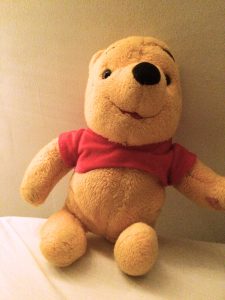In this mini-inquiry, teacher candidates were required to choose an object that meant a lot to them. Then we were asked questions about this object.
- What is it?

Where does it come from? Why is it meaningful?
My object is my Winnie the Pooh teddy bear. I’ve had it since the first year I immigrated here to Canada. One of my godmothers bought it for me. I remember it was the first toy I got here from the store. It was expensive and I knew I needed to take care of it. - Carefully observe your object:
What do you notice about its texture, temperature, smell?Texture is very different from a regular teddy bear. The smell is non-existent as it probably smells like me/my bedroom, in which I cannot smell my own scent.Try to ‘zoom in’ and look at detail, pattern, texture. What does this different perspective on your object evoke for you, remind you of? What do these observations evoke for you?
I think looking at the bear in detail, reminds me of how old this is. I’ve had it since I was five years old and it is the definition of my home. I’ve travelled around with this bear in every place that I’ve left the comfort of my own bedroom and is a reminder that home is a feeling, not a place.
- Write the story of your object
Where is it from? What is its history? Why and how is it significant to you? If you were to use this object as a metaphor, what would it be a metaphor for? What do the story and significance of your object suggest about your beliefs and values? How might those beliefs and values inform your work as a teacher?
The story of my Winnie the Pooh teddy bear starts for when my godmother bought it for me when I was at a toy store. I remember pointing at it from the top shelf and my she immediately bought it for me, despite my mom resisting because it was expensive. This was the year that we first immigrated to Canada. I had a lot of other toys but for some reason I was extremely attached to this one. Possibly because I chose it, rather than it being gifted to me. It is significant because it became an object of comfort. Whenever we flew, or moved countries, I had this one thing at night to help me sleep and remind me that everything was going to be okay. In the midst of all the change I was going through as a kid, I had this one thing that never grew, and stayed the same. It was always a piece of home.
I think the metaphor for this teddy bear is that no matter how the things around me are different or can change, I will always have a piece of home with me. It is a reminder that no matter how many changes are thrown my way, I am able to change and adapt to my surroundings. Material goods and physical places do not matter as much as things like family, friends, and knowing my own identity.
My beliefs and values as an adult revolves around growth and consistently trying to improve aspects in my life. I have made it a goal, especially this year, to constantly strive for something better.
I think that valuing growth plays a huge part in my teaching. As a teacher, it is my responsibility to constantly adapt to my students and my surrounding. It is my duty to be able to grow in my profession and also in my personal life and be a good example of being a learner of life.
